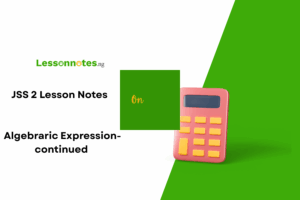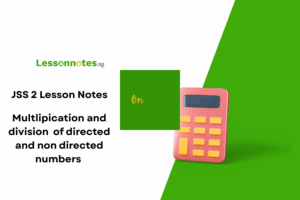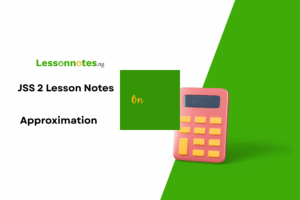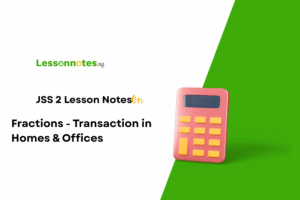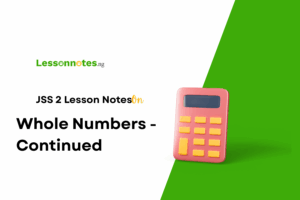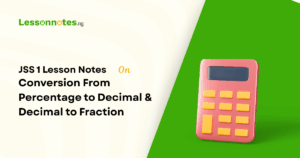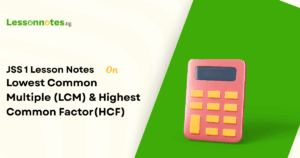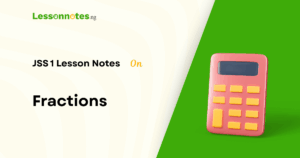Whole Numbers Counting & Writing JSS1 Mathematics Lesson Note
Download Lesson NoteTopic: Whole Numbers Counting & Writing
(Counting in Millions, Billions and Trillions)
In mathematics, we use ten basic symbols called digits to write all numbers. These digits are: 0, 1, 2, 3, 4, 5, 6, 7, 8, 9
When we combine these digits in different ways, we can create any number, no matter how large!
Let’s understand how numbers are grouped:
- Units (Ones): Single digits from 0 to 9
- Tens: Numbers from 10 to 99 (like 10, 25, 67, 99)
- Hundreds: Numbers from 100 to 999 (like 100, 456, 999)
- Thousands: Numbers from 1,000 upwards
The Place Value System
Every digit in a number has a specific position, and this position determines its value. This is called the place value system.
Table of Large Numbers
| Name | Value | Number of Zeros |
|---|---|---|
| One Thousand | 1,000 | 3 zeros |
| Ten Thousand | 10,000 | 4 zeros |
| Hundred Thousand | 100,000 | 5 zeros |
| One Million | 1,000,000 | 6 zeros |
| Ten Million | 10,000,000 | 7 zeros |
| Hundred Million | 100,000,000 | 8 zeros |
| One Billion | 1,000,000,000 | 9 zeros |
| Ten Billion | 10,000,000,000 | 10 zeros |
| Hundred Billion | 100,000,000,000 | 11 zeros |
| One Trillion | 1,000,000,000,000 | 12 zeros |
Quick Memory Tip:
- Million has 6 zeros
- Billion has 9 zeros (3 more than a million)
- Trillion has 12 zeros (3 more than billion)
PLACE VALUE CHART
When reading or writing large numbers, we use a place value chart. Each position has a specific name:
| Trillions | Hundreds of Billions | Tens of Billions | Billions | Hundreds of Millions | Tens of Millions | Millions | Hundreds of Thousands | Tens of Thousands | Thousands | Hundreds | Tens | Units |
|---|
Example: Let’s look at the number 75,800,074,890
| 7 | 5 | 8 | 0 | 0 | 0 | 7 | 4 | 8 | 9 | 0 |
|---|---|---|---|---|---|---|---|---|---|---|
| Tens of Billions | Billions | Hundreds of Millions | Tens of Millions | Millions | Hundreds of Thousands | Tens of Thousands | Thousands | Hundreds | Tens | Units |
This number is read as: Seventy-five billion, eight hundred million, seventy-four thousand, eight hundred and ninety
IMPORTANT RULES FOR WRITING LARGE NUMBERS
- Group numbers in threes from right to left using commas or spaces
- Example: 1234567890 becomes 1,234,567,890 or 1 234 567 890
- Use ‘and’ only before the last two digits (tens and units)
- Correct: Five hundred and twenty-three
- Incorrect: Five hundred and twenty and three
- Zeros act as placeholders – they show that a position has no value
- Example: 105 means 1 hundred, 0 tens, and 5 units
WORKED EXAMPLES
Example 1: Writing Numbers in Figures
Question: Write in figures: Twenty-five trillion, three hundred and five billion, six hundred and sixty-nine million, one hundred thousand and forty-one.
Solution:
Let’s break this down step by step:
| Place Value | Amount |
|---|---|
| Trillions | 25 trillion = 25,000,000,000,000 |
| Billions | 305 billion = 305,000,000,000 |
| Millions | 669 million = 669,000,000 |
| Thousands | 100 thousand = 100,000 |
| Tens and Units | 41 = 41 |
Now we add them together by stacking:
25,000,000,000,000
305,000,000,000
669,000,000
100,000
41
_____________________
25,305,669,100,041
Answer: 25,305,669,100,041
Example 2: Writing Numbers in Figures
Question: Write in figures: Ninety billion, three hundred and nine million, ninety-one thousand, seven hundred and sixty-three.
Solution:
Breaking it down:
| Place Value | Amount |
|---|---|
| Billions | 90 billion = 90,000,000,000 |
| Millions | 309 million = 309,000,000 |
| Thousands | 91 thousand = 91,000 |
| Hundreds, Tens, Units | 763 = 763 |
Stacking them:
90,000,000,000
309,000,000
91,000
763
_________________
90,309,091,763
Answer: 90,309,091,763
Example 3: Writing Numbers in Words
Question: Write in words: 456,789,012,345
Solution:
First, let’s identify each group:
- 456 = Four hundred and fifty-six (Billions)
- 789 = Seven hundred and eighty-nine (Millions)
- 012 = Twelve (Thousands)
- 345 = Three hundred and forty-five (Units)
Answer: Four hundred and fifty-six billion, seven hundred and eighty-nine million, twelve thousand, three hundred and forty-five
ORDERING NUMBERS (ASCENDING AND DESCENDING ORDER)
Ascending Order = Arranging from smallest to largest
Descending Order = Arranging from largest to smallest
Example 4: Arranging Numbers in Order
Question: Arrange these numbers in ascending order (smallest to largest):
28,980,579 | 18,967,547 | 2,897,871 | 36,497,871 | 36,479,568 | 18,898,069 | 36,478,967
Solution:
Step 1: Group the numbers properly in threes for easier comparison
Step 2: Compare the leftmost digits first (the millions place)
- Numbers starting with 2: 2,897,871
- Numbers starting with 18: 18,898,069 and 18,967,547
- Numbers starting with 28: 28,980,579
- Numbers starting with 36: 36,478,967, 36,479,568, and 36,497,871
Step 3: Within each group, compare the next digits to the right
Answer (Ascending Order):
2,897,871 | 18,898,069 | 18,967,547 | 28,980,579 | 36,478,967 | 36,479,568 | 36,497,871
PRACTICE EXERCISES
Exercise 1: Writing Numbers in Words
Write the following numbers in words:
(a) 567,256,789
(b) 18,000,901,234
(c) 3,456,789,012
(d) 125,000,000,000
Exercise 2: Writing Numbers in Figures
Write the following in figures:
(a) Three hundred and twenty-nine billion, five hundred and sixty-two million, eight hundred and one thousand, four hundred and thirty-three
(b) Fifteen trillion, six hundred and seventy-one billion, three hundred and ninety-one million, eighty-eight thousand, five hundred and fifty-five
(c) Seven hundred and eight million, forty-five thousand, two hundred and one
(d) Ninety-nine trillion, nine hundred and ninety-nine billion, nine hundred and ninety-nine million, nine hundred and ninety-nine thousand, nine hundred and ninety-nine
Exercise 3: Arranging Numbers
Arrange the following numbers in:
(i) Ascending order (smallest to largest)
(ii) Descending order (largest to smallest)
1,009,085,941 | 1,288,890,563 | 102,458,001 | 999,999,999 | 10,009,002 | 105,879,894,167
Exercise 4: Fill in the Blanks
(a) One million has _____ zeros
(b) 5,000,000 is read as _____
(c) The place value of 7 in 37,456,891 is _____
(d) The largest 3-digit number is _____
(e) One billion is _____ times larger than one million



